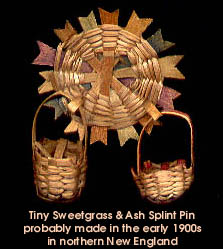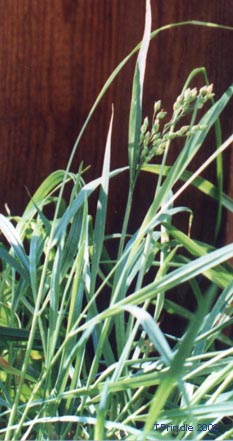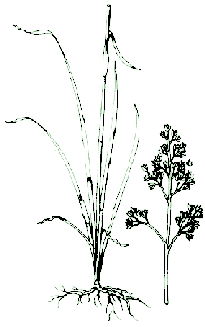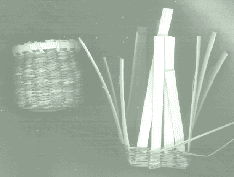
|
Sweetgrass is the hair of our Mother;
|

Sweetgrass is a circumboreal plant which is common above 40 degrees north latitude in Asia, Europe, and North America (Walsh 1994). In North America this fragrant grass grows regionally from Labrador to Alaska, and south to New Jersy, Ohio, Illinois, Iowa, South Dakota, Arizona and Washington (Larson 1993). Sweetgrass can be found growing wild in wet meadows, low prairies, the edges of sloughs and marshes, bogs, shaded streambanks, lakeshores, and cool mountain canyons. Sweetgrass rhizomes and roots form a dense mat beneath the soil surface (Walsh 1994).
Sweetgrass flowers from June through August and is easily identified by the sweet vanilla-like fragrance of itís leaves, its 3-flowered spikelets about 1/4 inch long, and its hairy lemmas. The stems of the grass are upright and hollow, growing up to 2 feet tall, without hairs. The leaves are elongated, narrow and flat (up to ľ inch wide, and are also hairless. The Sweetgrass flowers are borne in 3-flowered spikelets, which are arranged in a panicle up to 4 inches long. The spikelets themselves are about 1/4 inch long (the lower 2 flowers are male only, while the upper flower has both stamens and pistils (USDA n.d.).
Sweetgrass usually grows among other grasses or shrubs; it is seldom found in pure stands. Dried Sweetgrass foliage is fragrant because of its coumarin content (Walsh 1994). Sweetgrass is traditionally harvested in late June or early July. Sweetgrass harvested after exposure to frost has little sent. Care should be taken to cut Sweetgrass leaves and not to pull the grass up by its roots so it can grow again the next year. Weeding Sweetgrass areas lessens competition from other plants.
Sweetgrass (Hierochloe odorata) has a sweet, long-lasting aroma that is even stronger when the grass has been harvested and dried and is then moistened or burned. In the Great Lakes region, Sweetgrass was historically referred to with the Latin name Torresia odorata (Densmore 1974). There is also a western species of Sweetgrass (Hierochloe occedentalis) that grows in redwood areas. Other common names for Sweetgrass are Holy Grass (or Mary's Grass), Vanilla Grass, Bluejoint, Buffalo Grass, and Zebrovka.

Click Photo for Close-up of
flower just before blooming

Uses for Sweetgrass in Medicine & Ceremony
Densmore (1974) describes that among the Chippewa (Ojibwa), "young people, chiefly young men, carried a braid of sweet grass and cut off 2 or 3 inches of it and burned it for perfume. Young men wore two braids of sweet grass around their necks, the braids being joined in the back and falling on either side of the neck like braids of hair."
Sweetgrass is used to "smudge"; the smoke from burning sweetgrass is fanned on people, objects or areas. Individuals smudge themselves with the smoke, washing the eyes, ears, heart and body. Mi'kmaq have long used sweetgrass as a smudging ingredient, often mixed with other botanicals. Sweetgrass is one of the four medicines which comprise a group of healing plants used by the people in Anishinabe, Bode'wad mi, and Odawa societies. The other three are tobacco, cedar, and sage (Mary Ritchie 1995).
Among the Chippewa wicko'bimucko'si (sweetgrass) is braided and used in pipe-smoking mixtures along will red willow and bearberry, when it is burned, prayers, thoughts and wishes rise with the smoke to the creator who will hear them. Densmore (1974) describes the story of "a hunting incident in which a party of men placed sweet grass on the fire when the camp was in danger of starving and they were going again to hunt. Medicine men kept sweet grass in the bag with their medicinal roots and herbs".
A tea is brewed by Native Americans for coughs, sore throats, chafing and venereal infections. It is also used by women to stop vaginal bleeding and to expel afterbirth. It is warned that because the roots contain coumarin, that sweetgrass tea may be considered a carcinogenic. (Foster & Duke 1990)
Many Native tribes in North America use sweetgrass in prayer, smudging or purifying ceremonies and consider it a sacred plant. It is usually braided, dried, and burned. Sweetgrass braids smolder and doesn't produce an open flame when burned. Just as the sweet scent of this natural grass is attractive and pleasing to people, so is it attractive to good spirits. Sweetgrass is often burned at the beginning of a prayer or ceremony to attract positive energies.

(adapted from Foster & Duke 1990)

Uses for Sweetgrass in Baskets & Crafts
Ojibwe' on Manitoulin Island (among other places) make boxes from white birch bark, which is bound on the edges with sweetgrass and decorated with quills. My great grandfather, Chuhquat, made sweetgrass baskets for his granddaughters (Mary Ritchie 1995).
Frances Densmore (1974) explains that Among the Chippewa (Ojibwa), "strands of sweet grass were made into "coiled basketry" by means of cotton thread. This took the form of bowls, oval and round, and of flat mats. Birch bark was sometimes used as the center of such articles, the coils of sweet grass being sewed around it."
All of the Waban'Aki or Dawnland People used sweetgrass in making their baskets. The sweetgrass would be braided into small braids and then woven into the ash baskets. The Waban-aki are made up of the Abenaki, Mi'kmaq, Maliseet, Penobscot and Passamaquoddy, all of the northeast. An Abenaki friend of mine living in Portland Maine has a basket that his mother made probably 70 or 80 years ago that is made completely of sweetgrass and holds a sewing thimble like a glove (Louis Annance 1995).
 Trudie Lamb Richmond, Schaghticoke, spoke to a Mohawk basket-maker not long ago and asked her how she felt about weaving sweetgrass into her baskets. Sweetgrass is used by her people in their ceremonies and like tobacco is believed to have great power. It was used long ago in the ceremonial baskets and continued to be important even in those times when basket making became more material and less spiritual. She told me she had thought about this meaning and that was why she always talked to her baskets as she made them. She said that she asked forgiveness for having to sell the baskets, but that she needed the money to survive. Using the sweetgrass would keep the baskets strong and alive, and she hoped that the people who bought them would appreciate their significance. The basket weaver explained that she never picked the grass without making a tobacco offering. Her people believe that you have to give something for everything you take; even a tobacco offering is an acknowledgment. That is the old way, our way. (McMullen & Handsman 1987)
Trudie Lamb Richmond, Schaghticoke, spoke to a Mohawk basket-maker not long ago and asked her how she felt about weaving sweetgrass into her baskets. Sweetgrass is used by her people in their ceremonies and like tobacco is believed to have great power. It was used long ago in the ceremonial baskets and continued to be important even in those times when basket making became more material and less spiritual. She told me she had thought about this meaning and that was why she always talked to her baskets as she made them. She said that she asked forgiveness for having to sell the baskets, but that she needed the money to survive. Using the sweetgrass would keep the baskets strong and alive, and she hoped that the people who bought them would appreciate their significance. The basket weaver explained that she never picked the grass without making a tobacco offering. Her people believe that you have to give something for everything you take; even a tobacco offering is an acknowledgment. That is the old way, our way. (McMullen & Handsman 1987)
 Mi'kmaq tend to use sweetgrass as a decorative accent in basket-work, very rarely will you find baskets made entirely of sweetgrass and if you do, they are usually quite small (3-4" in diameter), have a cover and are often used for small sewing notions such as buttons, etc. (Capucine Plourde 1995).
Mi'kmaq tend to use sweetgrass as a decorative accent in basket-work, very rarely will you find baskets made entirely of sweetgrass and if you do, they are usually quite small (3-4" in diameter), have a cover and are often used for small sewing notions such as buttons, etc. (Capucine Plourde 1995).

you can visit the pages of Craig and Sue Dremann:
Redwood City Seed Co.
Box 361
Redwood City, California 94064.
Phone: (650) 325-7333
or you can write to:
Richters Herbs
Goodwood, Ontario, Canada
L0C 1A0
Tel. +1.905.640.6677
Fax. +1.905.640.6641


|
Text and Graphics
© 1994 - Tara Prindle unless otherwise cited. |